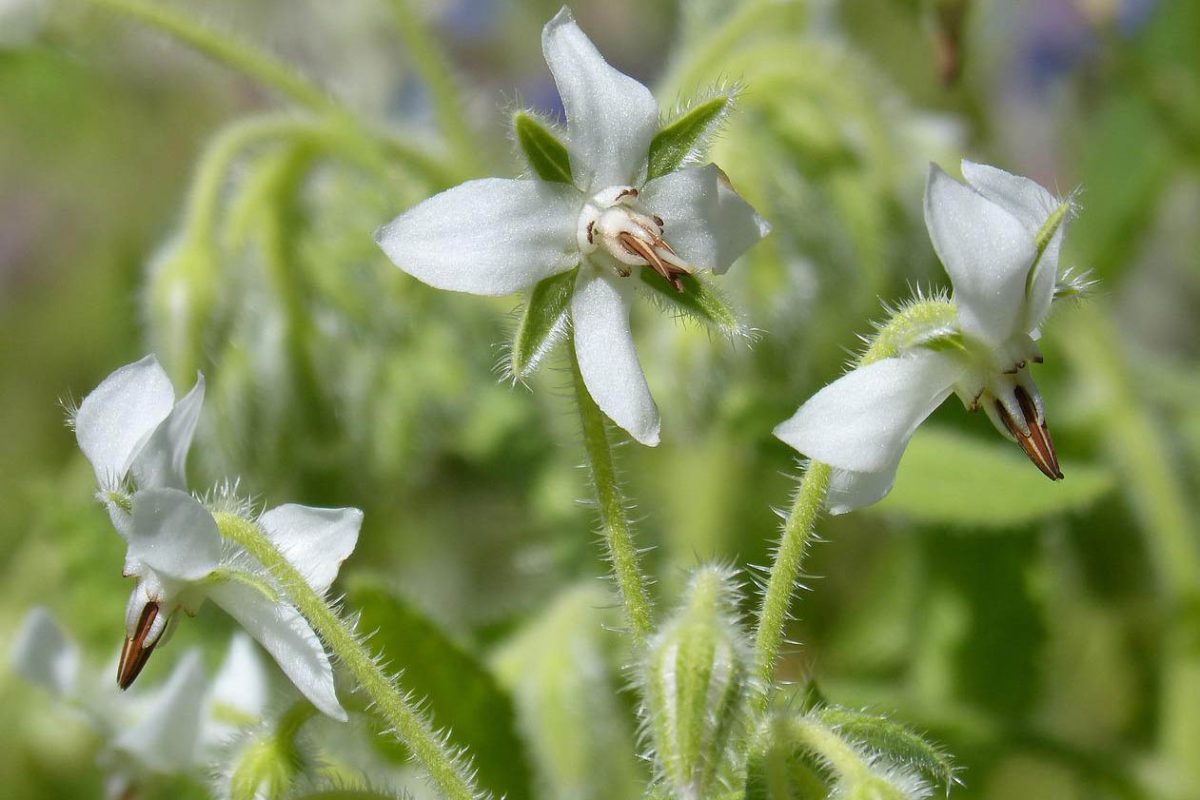What is borage?
Borago officinalis is an upright annual herbaceous plant native to the Middle East, Mediterranean, and North Africa, it is widely cultivated for its medicinal and edible properties. The name ‘Borago’ comes from medieval Latin, which means ‘short wool’, relating to the stems covered in fine hairs.
The five-petalled star-shaped blue or white flowers are used in ice cubes, scattered in salads and candied to decorate cakes and biscuits. Rough-haired, lance-shaped leaves have a mild cucumber taste and are used in salads and as a coolant in drinks.
Borage grows well in containers in peat-free compost or directly in the ground. It is especially useful in herb gardens and vegetable patches as it attracts pollinators and seed-foraging birds if allowed to go to seed.
Borage sowing guide

| Botanical name | Borago officinalis and Borago officinalis ‘Alba’ |
| Common names | Borage, Starflower, Common borage, Cool tankard, Tailwort, Beeplant, Cover crop, Beebread, Talewort |
| Plant type | Herb |
| Soil type | Fertile, well-drained |
| Soil pH | 6.6 |
| Soil germination temp | 18-29 C, 65-85 F |
| Sow time | Spring (after frost) |
| Moisture | Moist but not soggy |
| Fertilisation | Every 2-3 months during the growing season |
| Pollination | Self-pollinating |
| Insect attracting | Bees, wasps, hoverflies, butterflies, seed-eating birds |
| Companion plants | Cabbage, tomato, squash, zucchini (courgette), strawberries |
| Plant height | 50-90 cm, 19-35 in |
| Spread | 22-60 cm, 8-23 in |
| Flower colour | Blue, White |
| Seed depth | 10 mm, 1/2 in |
| Spacing | 30 cm, 12 in |
| Germination | 7-10 days |
| Location | Full sun, partial sun |
| Special treatment | None |
| Bloom time | Summer to autumn |
| Scarification | None required |
| Stratification | None required |
| Toxicity | All parts contain pyrrolizidine alkaloids |
| Symbolism | Courage, romantic longing |
Uses
Young borage leaves are used to make soups, pasta fillings and pickle flavourings. The flowers have a sweet honey flavour and can be used in salads, candied or frozen into ice cubes and are the traditional garnish served with Pimm’s. Gol Gav Zaban is a popular Persian tea using dried borage flowers.
Borage seed oil has a high gamma linoleic acid (GLA) content, an omega-6 fatty acid thought to reduce inflammation. It is used to treat a number of conditions including rheumatoid arthritis, eczema, seborrheic dermatitis, psoriasis, rosacea, and neurodermatitis. Always seek medical advice before taking any supplements.
In traditional medicine, borage has been used as a sedative, diuretic and used as treatment for respiratory, cardiovascular and gastrointestinal disorders.
Toxicity
While borage has many medicinal and culinary properties, all parts of the plant contain pyrrolizidine alkaloids (PAs) which are toxic to the liver, and lungs and may also be carcinogenic, especially when consumed in high doses. Pregnant or lactating women and people with liver problems should avoid borage.
Notes
Borage can be sown indoors and transplanted outside in areas prone to frost. This allows the seedlings to get a head start without the risk of a late-season frost harming the tender seedlings.
Always water in seeds after they have been sowed as water is necessary to help break down the seed coat. Be careful not to saturate the soil, however.
Harvesting borage is simple, use a sharp pair of scissors to cut off the flower heads and use in salads, cakes or ice cubes.
Borage seeds do not require cold stratification or scarification.
Seedlings emerge between 7-10 days after they have been sowed, and reach maturity by eight weeks. Successive planting will ensure you have a steady supply of borage.
Julia is a writer and landscape consultant from Wollongong with a love of horticulture. She had been an avid gardener for over 30 years, collects rare variegated plants and is a home orchardist. Julia is passionate about learning and sharing her knowledge of plant propagation and plant toxicology. Whether it’s giving advice on landscape projects or sharing tips on growing, Julia enjoys helping people make their gardens flourish.




